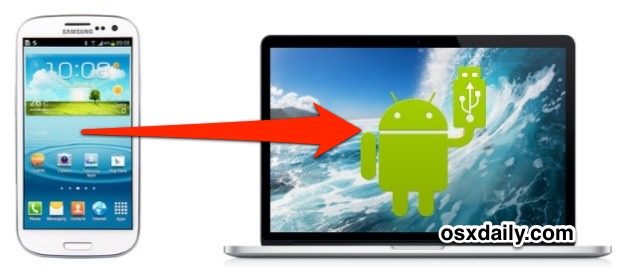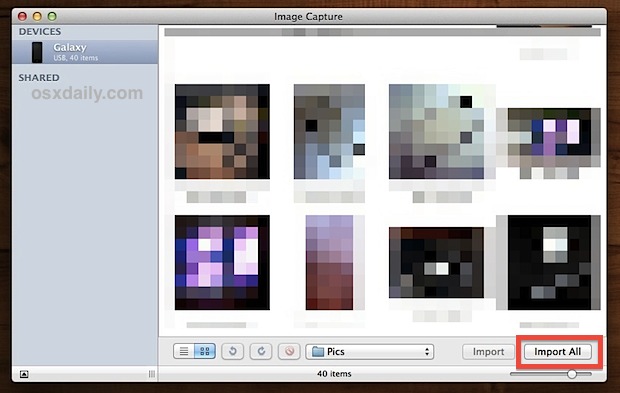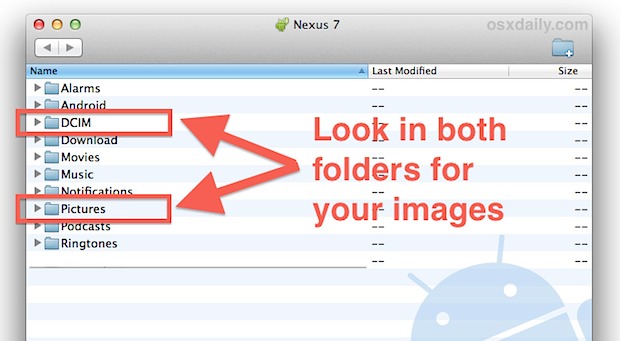Transfer Photos from Android to Mac OS X

The easiest way to copy pictures from an Android device and to a Mac is using one of the image transfer apps that is bundled with Mac OS X. That’s because all Android devices, including the popular Google Pixel, Nexus, Huawei, Xiaomi, OnePlus, and Samsung Galaxy series, should be treated by the standard camera apps in Mac OS X as if they were a digital camera, all you’ll need to do is launch an appropriate app and connect the Android device to the Mac with a USB cable. We say ‘should’ because it doesn’t always work that way, so another great option is to use the Android File Transfer app, and when Image Capture or otherwise fails it’s almost guaranteed to work. We’ll walk through several different methods for transferring photos from Android to your Mac with a variety of solutions.
Longtime Mac users familiar with digital cameras or the iOS world will find that with the exception of the AFT app, these are the same methods used when copying pictures from an iPhone, iPod touch, or iPad to a computer as well.
Copying Pictures from Android to Mac with Image Capture
Image Capture is the preferred choice for transferring pictures from just about any digital device to the Mac. It’s fast, efficient, provides a thumbnail preview, and lets you delete the pictures from the device afterwards if you want. It’s no frills but gets the job done quick, here’s how to copy pictures from an Android phone to a Mac with this app:
- Connect the Android device to the Mac with a USB cable
- Launch “Image Capture”, which is found in the /Applications/ folder
- Select the Android phone under the ‘Devices’ list on the left side of Image Capture
- Optionally but recommended, select a destination folder for the photos
- Click the “Import All” button to transfer all pictures on the device to the Mac
Image Capture also lets you selectively pull pictures off the device by selecting them from the window, then choosing “Import” rather than the Import All button.

When finished, locate the destination folder you specified in the Mac OS X Finder and all of your pictures will be there.
Some Android devices seem to have issues with Image Capture though, and if you encounter any such problems you should download Google’s Android File Transfer utility and use that instead.
Copying Photos from Android to the Mac with Android File Transfer
Android File Transfer is a file management app that lets you copy files to and from a Mac to an Android device, and naturally that means you’ll also have access to photos and movies too. If for some reason there is an issue with Image Capture not recognizing the Android device, then Android File Transfer is the next best thing and will almost certainly recognize the device so long as it’s running Android 3.0 or later (most devices are):
- If you haven’t done so yet, download FileTransfer from Android.com and install it on your Mac by placing it into the /Applications/ folder
- Connect the Android device to the Mac with a USB cable
- Launch Android File Transfer and wait for it to recognize the device
- Photos are stored in one of two locations, the “DCIM” folder and/or the “Pictures” folder, look in both
- Use drag & drop to pull the photos from Android to the Mac
Android File Transfer will show a progress bar with the estimated time remaining, how many pictures are copying over, and an option to cancel the file copy.

In terms of the two folders, “DCIM” tends to be where pictures taken with the digital camera apps appear, whereas “Pictures” is usually where photos saved from apps appear. That is not always the case though, which is why we recommend looking in both locations to be sure you find the items you’re looking for.
Android File Transfer is one of those apps that all Mac users who also own an Android tablet or phone should have handy. You’ll find that if you explore the device a bit with AFT, there is access to much of the Android devices file system. Though it’s neat to have raw direct access to a lot of these files some of the data shouldn’t be bothered with manually, and for things like email, calendars, and notes, you can sync those between Mac OS X and Android with fairly little effort.
Using Preview App for Image Transfers from Android to Mac OS X
Preview is the standard image viewing application for Mac OS X that can also serve as a means of copying photos from cameras, phones, and tablets.
- Launch Preview after connecting the Android device to the Mac
- Pull down the “File” menu and near the bottom of the menu options choose “Import from (device name)”
- Select the images to transfer, then choose “Import”
Preview’s interface for copying pictures is a lot like Image Capture, but with less options, and there is also no option to automatically launch and import the photos upon connection.
Using Photos app or iPhoto
Photos app and iPhoto should recognize the Android device as a camera immediately upon launch. There isn’t much to using iPhoto for this purpose, just launch the app after connecting the device to the Mac and it should gather all photos and provide an option to import them all. Photos and iPhoto really functions more as an image manager mores than a transfer app though, so we won’t spend too much time on it for this purpose.
Thanks to Jaydeep for the tip idea. If you have any tips or tricks for transferring photos from Android to Mac, share with us in the comments below!


transfer photos from Samsung Galaxy Android phones to your computer is so easy
Hi I need help. I am trying to transfer photos from my Android to Mac OS. I downloaded the Android File Transfer app to my Mac. I got up to the point where I can copy the files from phone to desktop. However, when I try to look at my photos from the DCIM from my card, the folder is empty. Any help would be appreciated.
Thank you.
Have 1 yr old iMac and Galaxy 4S (Android 4.4). Followed the instructions, several times, but nothing. DCIM says either ‘no access’ or shows nothing in the folder.
Ideas?
You can use backup programs. And the android transfer app allows you to save a lot of time to transfer or backup text messages, contacts, photos, and other media files like videos, music files. Have a try of a tool that I am using now, MobiKin Android Transfer.
I have been using android file transfer for a while now and it’s always pretty much worked fine, however for some reason It’s not finding about a month and a half worth of pictures now (which I need to back up as they are pictures of my uni notes). I’ve searched everywhere where pictures could be saved (they were taken with the phones camera, so should be in DCIM) and have tried both using File transfer and Photo transfer, for some reason they just don’t appear on my mac. Has anyone had similar problems or know how to fix it?
Thanks for the tips…I’ve tried the Mac file transfer software, and Android Transfer. The problem is that neither of these programs recognize my phone…a OnePlus 3T running Nougat.
Guess I’ll just ship the photos to Google photos or Drop box and go from there.
Thanks again, guys and ladies.
I used Image Capture, took about over two hours to import all and it showed that they have been imported and saved in the Picture folder, but when I locate the Picture folder and open it it’s empty.
I had about 20,153 items and spent way too much time to not get any results. :/
Search for the files, if you copied them from the Android to computer they are there on the Mac.
none of these work for me
great i this helps me a lot… :)
thank you thank you thank you very helpful and easy
My iMac El Capitan does not detect that my moto g3 is plugged in via a usb cable
thank you for this. Question, could it be that the android transfer app allows me to only drag one photo at a time? i tried command A & it doesn’t work…
Try using Option + Shift + Down Arrow 1 time and you should select everything.
i have a mac (osx 10.7.5) and a new samsung j1 (android 4.4.4). i’m able to transfer photos via image capture but the android file transfer simply doesn’t work: 1 second after i plug the usb always the same error message: “could not connect to the device”. why? the same goes with the samsung kies app.
Use the Image Capture app to transfer your photos from Android to OS X, you can use Image Capture on Mac with Samsung phones or any other Android phone, it recognizes it as a camera.
Yeh, WHEN or IF it works!! LOL. I can’t get it to work at all. Error 21345 but no instr. on how to rectify! Aaaarrrggg
What should I do, when the app give me this text every time I try to use it “Could not connect to device.Try reconnecting or restarting your device.” ???!! Help meeee !!!:/
In the first way you provided, you forgot to say that you have to change in the settings this:
Camera (PTP)
Allows you to transfer photos
using camera software, and
transfer any files onto PC that do
not support MTP
In this is usually in the notifications bar (the thing you scroll down) :)
I want to copy my photos from my Galaxy Nexus to my iMac. While I want a copy of all the photos on my iMac, I do want to retain some on my phone. I’m unclear if I will simultaneously be deleting them from the phone or not by following the above instructions. Can someone answer this, please?
Wow I did it, with the help of the instructions on this page! I have a new Mac Mini and a Samsung Galaxy Nexus phone and I wanted to get the photos off of the phone. Image Capture didn’t work, so I googled around for help and found this page. By using the DCIM option in Android File Transfer I found my photos and moved them onto my desktop into their own folder. 700 megs worth of pix took under a minute to transfer. I am thrilled as I didn’t think I was going to be able to do this.
Maybellene in Ontario Canada
HOW did you get it to do that? Were you able to have them “all” selected and then hit the “transfer button”? Can’t seem to get any of the programs to do that, not even “option+shift+down arrow!
Using an HTC one and MacBook pro with OSX. Can’t get image capture to recognize or browse device to link with phone. I searched for apps or software to correct this, does anyone know of an easier solution? Using file transfer, you may not send the photos directly to iPhoto but only to desktop or downloads which is rather inconvenient having to move them all. I’m creating a photo album and the extra work after transferring hundreds of photos is awful. Suggestions?! Please and thank you! :)
In my experience the easiest way to transfer Android photos directly into iPhoto on a Mac is by importing them as usual as described here, then dragging & dropping that entire folder into the iPhoto icon on the dock. This will start the import process in bulk. You can also import them directly from iPhoto from the Android by connecting it as a USB drive, but it seems slower.
can someone please help me… i have a note and it wont let me copy anything, says the files are not valid
Thanks!!!
Thank you for posting this article. I stumbled upon your page when trying to find a way to transfer images from a Google Nexus 5 running Android KitKat 4.4 to my Macbook. I thought that simply connecting the phone to the USB port would show the phone as a USB drive. But that wasn’t the case! While your instructions may be correct for Android 4.3 and prior releases, I want to share about the enhancements made to KitKat which make it easier to use Image Capture for transferring images to a Macbook.
After connecting my Nexus 5 to the computer, I started Image Capture but the device wasn’t recognized. On the phone, there was a notification that a USB connection has been detected. Touching the notification brought up the “USB Computer Connection” screen which has two options with checkboxes as listed below.
1) Connect AS:
Media Device (MTP)
Lets you transfer media files on Windows, or using Android File Transfer on Mac (see http://www.android.com/filetransfer)
2) Camera (PTP)
Let’s you transfer photos using camera software, and transfer any files on computers that don’t support MTP
The default is option 1 due to which phone will NOT be recognized by any photo software. I selected option 2 and now was able to see my photos in Image Capture.
Hope this helps!
Brilliant!! Thanks Rajesh. Defintely that helped.
YESSSSSSSS… WINNER!!
Rajesh, Thank goodness for your instructions! I have been trying to figure out how to get my Samsung Galaxy 5S photos on my newer Macbook Pro for 2 days now! I followed all directions but nothing worked, I was getting ready to bring my computer in but thankfully, I just read your reply and now got my photos transferred! My cell phone was set to “media device” I changed it to “Camera (PTP)” and voila! it worked immediately. Whew! I thought MacBooks were supposed to be so easy but they are not! Thanks again for saving the day for me!
No! This will not work with a Samsung S3 with Jelly Bean OS or even the older OS. Just download Samsung Kies and forget about it. I wish it did work because I always like generic solutions over proprietary. It’s Samsung’s fault not Apple’s. Still love my Samnsung S3!
Hah…I was literally browsing out of boredom only to find EXACTLY the answer to a question that I needed an answer to for my GF’s Galaxy S III. Well, almost. I’m actually not only trying to get her photos off her Android device, but move them to the 16GB microSD card that I just installed for her the other day. Being unfamiliar with Android as an OS, I did make her SD card the destination for all future pics/videos that she likes to shoot, but she’s still running out of main memory.
Or the easiest way: get a Dropbox account and use the photo upload feature of Dropbox for Android (or iOS, for that matter) to sync all your photos with your Dropbox account.
What @CRB describes ends up being a lot like Photo Stream for Mac and iOS, all of your pictures will sync themselves between Dropbox on Android and Dropbox on the Mac or PC. Windows users have it the easiest though, they can access the Android camera like it’s a folder in My Computer with Plug and Play.
By the way for anyone in the market, the Nexus 4 and Galaxy S3 are two really good phones that work very well with the Mac without a fuss.
or Ubuntu One
http://bracaro.tumblr.com/cloud
When will OSXDaily finally stop telling its readers to search for an application in the Applications folder? We don’t live in the ’90s anymore, it’s 2013. We don’t start an application from the Finder anymore, we’ve been using Launchpad for a long time now and even before Launchpad we had the Applications stack in our Dock.
Forget all that, use Spotlight to launch applications instead. Covers all versions of OS X and it’s the fastest.
I have been doing that lately. :)
Don’t be so shortsighted. There is no telling what OS people are using, only that it’s OSX.
I know plenty of systems still on 10.4 and even more on 10.5, and these are not going to have Launchpad.
OSXDaily have posted a solution for everybody.
We try to always point out the full path when possible, because sometimes we talk about apps that are in less obvious places, whether it’s the /Applications/Utilities/ folder or ones that are buried within the System folders. Spotlight and Launchpad are definitely two fast and easy ways to launch apps though!
Shut up prick. Be glad you have a big house to live in the suburbs and your nice cars and your IMac, IPhone, Macbook, IPad and all other Apple Products you spend big money for. First world problems
Wow you’re panties are sure in an uproar eh? Geeezus lay off okay? Cripes.
Did you know that archive utility is not in the applications folder?